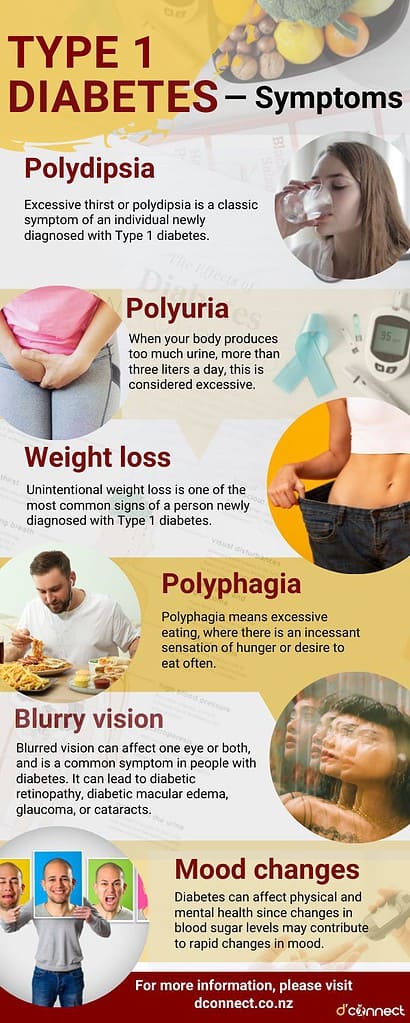
Joyce Roberts
BHSc Nsg, Post Grad Cert Adv Nsg, Post Grad Dip Adv Nsg, Accredited Diabetes Nurse Specialist
An individual who is diagnosed with Type 1 diabetes usually reports a short and dramatic history of
- Polydipsia (extreme thirst)
- Polyuria (excessive urination)
- Weight loss and weakness
Other symptoms include
- Polyphagia (excessive eating)
- Vision changes
- Mood changes
In this article, we will look into these symptoms and go into more detail, which might help certain individuals to react faster and seek medical attention sooner.
Polydipsia
Excessive thirst or polydipsia is a classic symptom of an individual newly diagnosed with Type 1 diabetes.
RELATED — Type 1 Diabetes: Autoimmune disease that is on the rise
When glucose is not absorbed by the cells in the body, it eventually goes to the kidneys, and urine becomes more concentrated with glucose. This attracts water, which then leaves the bloodstream and diffuses into the urine.
With less water in the bloodstream, there are also fewer electrolytes.[1]
Sodium is an electrolyte which helps regulate the amount of water that’s in and around our cells. This loss of water can also affect the levels of potassium.
The bloodstream is now more concentrated with sodium, it now lacks water, and this leads to increased thirst.
With electrolytes at low levels, both behavioral and neurological changes such as lethargy, headaches, seizures, confusion and coma are seen.
Polyuria
Polyuria is where the body urinates more than usual and passes excessive or abnormally large amounts of urine.
A normal adult produces 1-2 litres of urine a day compared to the 3 litres due to polyuria.
As we already mentioned, in Type 1 diabetes excess glucose ends up in the urine where it pulls in more water. This results in more urine being produced which leads to dehydration.
The person with diabetes who has ongoing frequent urination and hyperglycemia also risks developing thrush.
Significant weight loss and weakness
Unintentional weight loss and muscle wasting is one of the most common signs noticed more by the family or partners of the person newly diagnosed with Type 1 diabetes.[2]
The amount that has been lost is individualized to age, calorie intake and overall health.
Unexplained and unintentional weight loss of over 5 % of your body weight is classed as significant loss.
This weight loss is a result of insufficient insulin preventing the body from getting glucose to use as energy.
When this occurs, the body starts burning fat and muscle for energy, which causes weight loss and muscle wasting.
Polyphagia
Polyphagia is the medical term for excessive eating. Polyphagia in a person newly diagnosed with Type 1 diabetes is related to hyperglycemia (high blood sugar levels).
Hyperglycemia increases the craving for food
In particular, the body is looking for sugar because it relies on this delivery of glucose to function properly.
When there is insufficient insulin available to transport the glucose to the brain, and other cells throughout the body, the brain thinks there isn’t enough food and sends signals and cues for hunger.[3,4]
The body is then plunged into a vicious cycle of eating until the blood sugar levels rise.
Without sufficient insulin to deliver the glucose to the cells, there is a build-up of glucose in the bloodstream which causes damage to the body and the organs.
Blurry vision
In Type 1 diabetes individuals blurred vision can affect one eye or both eyes due to the presence of glucose in the lens of the eye.
This causes alteration in the shape of the lens and subsequent blurring of vision due to altered refraction.
Mood changes
The human brain requires glucose to function.[5] When there is insufficient glucose in the blood, the brain is “starving” for energy.
The mood changes occur due to the brain’s lethargy and we find it difficult to control ourselves.
Summary

Note — feel free to download or share this image.
Related Questions
1. What are the 3 main symptoms of Type 1 diabetes?
There are three main warning signs that everyone should look out for and they all begin with the letter P. These are
- polyuria
- polydipsia
- polyphagia
If you or anyone you know is experiencing any of these signs please go and see your Doctor.
2. How much water should a Type 1 diabetic drink daily?
The recommended water intake for women is 1.6 litres or 6.5 cups and for men 2 litres or 8.5 cups per day.
For the person who has developed diabetes, water helps fight dehydration but it also helps get rid of excess glucose.
During episodes of hyperglycemia it is recommended you increase your water intake to help flush the excess glucose in your system.
3. How often should a Type 1 diabetic eat?
It is recommended that the person with Type 1 diabetes eats every 3-4 hours to match the insulin type they take at meal times and to help prevent hypoglycemia.
Different approaches will be required for different people because not everyone’s circumstances are the same.
If you are looking for more articles on diabetes, please check our section on Health Conditions.
Joyce has been nursing since the 1980s, and for the past 20 years she has been focusing on patients with diabetes.
Given that diabetes can be a debilitating disease if not managed properly, Joyce’s focus is to ensure that individuals with diabetes have all the correct information. She works diligently and her focus is to prepare, inform and make sure that the individuals are well equipped with knowledge and support to live with the disease 24 hours a day.
References
(1) McDowell, Joan,Matthews, David,Brown, Florence. (2007). Diabetes: a handbook for the primary healthcare team.
(2) Davies, N. (2010). Improving self-management for patients with long-term conditions. Nursing Standard.
(3) Holt, Richard., DeVries, J., et al. (2021). The management of type 1 diabetes in adults. A consensus report by the American Diabetes Association (ADA) and the European Association for the Study of Diabetes (EASD). Diabetologia. https://diabetesjournals.org/care/article/44/11/2589/138492/The-Management-of-Type-1-Diabetes-in-Adults-A
(4) American Diabetes Association Position Statement. (2004). Hyperglycemic Crises in Diabetes. Diabetes Care.
(5) McCance, K., Huether, S., Brashers, V., Rote, N. (2010). Pathophysiology. The Biologic Basis for Disease in Adults and Children.






